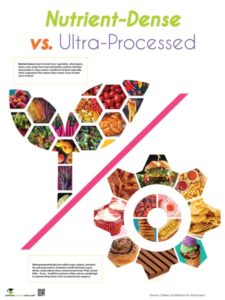It seems like processed and ultra-processed foods have been in the news a lot lately.
While some people get mired in conversations about what foods should be considered processed (canned beans? whole grain bread?), you can’t go wrong by promoting a plant-based eating pattern that’s centered on vegetables, nuts, seeds, legumes, whole grains, and fruits.
We have some great ways to get your students, clients, or employees off the processed food track and on the road to a plant-based eating pattern.
1. One of our newest posters uses pictures to encourage nutrient-dense foods over ultra-processed ones:

Nutrient-Dense Vs Ultra Processed Food Poster 18x24 Laminated - Nutrition Poster
$19.00 $24.00
Add to Cart
2. One look at this poster (which also comes as a banner, stickers, and bookmarks) kind of says it all:
3. If there’s a health fair in your future, create an eye-catching display with our Real Food Grows theme materials. You’ll really get their attention when you wear our fruit and veggie mask!
By Hollis Bass, MEd, RD, LD
Free Handout: Nutrient-Dense vs Ultra-Processed





